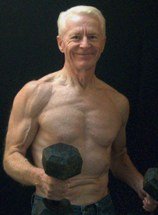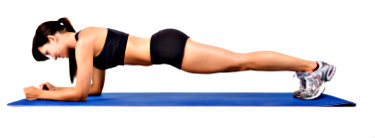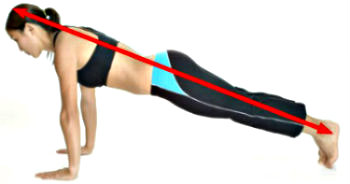| Back to Back Issues Page |
 |
|
The Gray Iron Fitness Newsletter, Issue #139, Test your level of physical fitness. June 01, 2014 |
Hi
June 1, 2014
In this newsletter . . . Take this fitness testA family that planks together
Take this fitness testIt's been ten years since I last tested myself by doing my Deck of Cards workout. It’s a butt-kicker, and in a minute I’ll tell you how it works. But first, it's important to know this is not a beginner’s test. Beginners should start their training with something specifically for them.But for those ready to test themselves, do the following: Get a deck of playing cards. Assign an exercise to each suit. I assigned them as follows:
Shuffle the deck several times. Place the deck face down. Start your stopwatch or timer. Turn over the first card. Let’s say it’s a seven of hearts. Clean & Press your dumbbells seven times. Turn the next card. Suppose it’s a nine of spades. Do nine bodyweight squats. With each card, do the same number of reps as the number on the card. The face cards are considered tens. Aces are eleven. Remove the jokers or keep them and assign them any number you want to. (I remove the jokers.) Keep going through the entire deck. Then check your stopwatch. Write down the time for your record. The idea is to go through the deck as fast as you can. If you do it that way, it’s a test — and butt kicker. Of course, the workout is not so difficult if you casually go through the deck. In shape athletes do the workout in less than 30 minutes. The training is supposed to be popular with Japanese wrestlers and judo competitors. But they often confine it to two exercises, such as squats and pushups. I like to do it with four. How did I do, personally? The first time I tried it took me 27 minutes. Then when I tested in 2003, I did it in 20:53.79. However, I used a different exercise mix, which may or may not have been less taxing. I tested twice in 2004, finishing once in 21:27.75 and once in 22:22.25. Though the exercise mix was slightly different each time (meaning there is some degree of “comparing apples with oranges”), there is no denying that I’d lost a step or two. Age happens. But I was still under 30 minutes. I’ve since done the deck of cards routine as a workout. But it’s been 10 years since I used a stopwatch and gave it everything I had. This is not a recommended test for beginners. If you like the newsletter, we're making it easy to share it . . . A family that planks togetherOne of my daughters, Jennifer, is a trainer in Austria but is now here in California for the summer.For the past couple of years she has provided some of the Gray Iron exercise videos. I told her she was providing an invaluable service. Even so, I also told her she was ineligible to be a newsletter subscriber until she turned 50, which she did last month. Of course I was kidding her. Most subscribers are seniors, but anyone at any age can subscribe. Jennifer has always liked working out. (I wonder where that comes from?) She also has a project in which family members – kids, grand-kids, parents, and a few close friends – participate. The only requirement is that each day you must plank. The plank is a popular yoga-like isometric position that primarily strengthens the body’s core, the erector spinae, rectus abdominus (abs), and transverse abdominus. Secondarily, it strengthens, traps, delts, pecs, glutes and quads. There are standard planks and several variations; each brings different muscles into play, through the core is primary in each nuance. No one gets kicked out of Jennifer’s plank club for doing a variation. But for our daily planking get-together, most of us do one of the two standard types: either
Family planking: Each day she sends a text message to everyone, wherever we may be: It is time to plank, she says. And we all begin. Each person's planking time goes according his or her ability. Many send Jennifer a text afterward giving their planking time for the day, particularly if a personal best is established. But notification of completion is voluntary. We're on the honor system. If you want to plank, and have never done it before, begin with short hold attempts of several seconds, and progressively add seconds to your plank time. Don't slump, slouch, droop or raise your hips. Keep a straight line. Progress comes just as it does in beginning weight training, where you begin with very manageable weights, and progressively add to them. By the way, according to Guinness World Records, the longest held plank is 3 hours, 7 minutes and 15 seconds, set in Newport, Kentucky, on April 20, 2013 by George Hood. I can barely imagine it! Three hours in a plank? We are steady. But Mr. Hood needn’t worry that any of us might challenge his record. 
Newsletter Policy The Gray Iron Fitness Newsletter is a free publication sent twice monthly to subscribers. The purpose is to provide honest and realistic fitness information for people age 50 and above. I have never been paid or received compensation of any kind to write a positive review or endorse a product. If I say that I personally use a product or service, it is because I find value in it and have paid for it with my own money. Like newspapers, magazines and television, this newsletter and my web site contain advertising and marketing links. Naturally, I am compensated for these. The newsletter and web site provide information to help users establish and maintain a fitness lifestyle. But fitness information is not the same as fitness advice, which is the application of exercise and dietary practices to an individual's specific circumstances. Therefore, always consult with your physician for assurance that fitness information, and your interpretation of it, is appropriate for you. Your comments and questions are always appreciated. Simply click on the "Reply" bottom. |
| Back to Back Issues Page |

